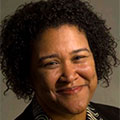Perspectives on the 1619 Project
 Download Q&A
Download Q&A
Perspectives from:
1. What were the origins of the 1619 Project and what is its purpose?
Harris: The 1619 Project is an ongoing focus of the New York Times Magazine, initiated by reporter Nikole Hannah-Jones and supported by NYT Magazine editor Jake Silverstein. It both commemorates the year in which 20 to 30 people of African descent landed in Virginia, and investigates the ways that the history of slavery and anti-black racism continue to impact the United States. Although historians have debated whether these people were enslaved, most believe that they were held in some kind of bondage on arrival, and that many of them or their descendants gained freedom. But by 1705, Virginia had instituted the first body of slave codes in the British North American colonies that would come to form the basis of the United States. These codes identified slavery uniquely with people of African descent, and that the status of enslavement was inherited: those born to enslaved women were assumed to be slaves via the legal doctrine of partus sequitur ventrum: that which is born follows the womb. These slave codes also regulated what enslaved people could and could not do; expanded to limit the rights of free people of African descent; and came to form the basis of slave codes in the United States until slavery was eradicated by the 13th Amendment to the U.S. Constitution. Nikole Hannah-Jones was inspired by Lerone Bennett’s popular 1962 African American history book, Before the Mayflower: A History of Black America, 1619-1962. By identifying the arrival of enslaved Africans in 1619 in Virginia, Bennett challenged the idea that the Pilgrims who arrived in Massachusetts were the only important colonial history of the United States, which was the standard account at the time the book was published. At the time, many believed that slavery was unimportant to the Massachusetts colony or to any colonies north of Maryland, a belief we now know to be erroneous.
Wood:
The 1619 Project began with a proposal in January 2019 from Nikole Hannah-Jones to the senior editors of the New York Times. Racial tension was on the rise at the Times, and Hannah-Jones’s project became a central priority for the newspaper. The goal of the 1619 Project was to “reframe” American history—from the old story of people seeking self government under the rule of law and grounded in the principles of liberty and equality—to a new story of America as a system of racial oppression grounded in white privilege, exploitation of weak by the strong, and rampant hypocrisy (“false ideals”) intended to camouflage the deep injustice of slavery.
The 1619 Project was originally presented as a work of “history,” but after more criticism of its numerous and significant historical misstatements, Hannah-Jones recharacterized it: “[T]he 1619 Project is not a history. It is a work of journalism that explicitly seeks to challenge the national narrative….”
2. Who developed the 1619 Project?
Harris: Nikole Hannah-Jones is an award-winning reporter. Prior to the 1619 Project, she was most well-known for her in-depth reporting on racial inequality in US housing and education for Pro Publica and the New York Times, which led to her being named a MacArthur Fellow in 2017. In July 2021, Hannah Jones was appointed to the Knight Chair in Journalism and Race in the Cathy Hughes School of Communication at Howard University, where she is also the founder of the Center for Journalism and Democracy there. Jake Silverstein, editor of the NYT Magazine, greenlit the idea for the 1619 Project. Leading academics, journalists and artists contributed long and short researched and interpretive essays, poetry, and photography to the magazine issue. In addition, the Pulitzer Center on Crisis Reporting developed a curriculum for K-12 teachers to use in their classrooms alongside the project.
Wood:
Nikole Hannah-Jones earned a B.A. from the University of Notre Dame in history and African-American studies (1998) and a master’s degree in journalism from the University of North Carolina (2003).
The 1619 Project includes ten main articles. Of the nine other authors, five are journalists, two are academic historians, one is an academic sociologist, and one is a practicing attorney. None of them specialized in American history before the 20th century.
The 1619 Project did not engage any leading historians, but before publication, the editors asked a specialist in pre-Civil War African American history at Northwestern University to fact-check one of the central contentions of the 1619 Project: that the Revolutionary War was fought to preserve slavery. That professor vigorously disputed that claim, but the Times ignored her and never disclosed her criticism.
3. How does the 1619 Project present American slavery in its historical context?
Harris: The main essays in the 1619 Project seek to show the connection between the enslavement of people of African descent to contemporary legacies of racial inequality. Although the project begins with slavery, it also has numerous essays on post-emancipation racial segregation in the 20th and 21st centuries. The lead essay by Nikole Hannah-Jones is a meditation on her personal engagement with U.S. and African American history over the course of her life, and how learning about the history of racism in the United States has affected her own thinking about the meaning and experience of patriotism. Subsequent essays include but are not limited to Linda Villarosa on the racialized history of medicine; Khalil Gibran Muhammad on the history of slave-produced sugar and the current impact of sugar consumption; Kevin Kruse on 20th-century segregation and urban built environments; Wesley Morris on black music; Bryan Stevenson on the relationship between slavery and mass incarceration; Trymaine Lee on 20th- and 21st century real-estate practices of redlining and evictions that disproportionately affect people of African descent in the U.S. The original project also contains 16 poems and short stories including works by Clint Smith, Yousuf Komunyakaa, Eve Ewing, Reginald Dwayne Betts, Tyehimba Jess; Barry Jenkins, Jesmyn Ward, Darryl Pinckney, ZZ Packer, Yaa Gyasi, and others; a photo essay highlighting the descendants of enslaved Africans who were students at Howard Law School at the time of the magazine’s publication; and a separate pull-out section in collaboration with Mary Elliott of the Smithsonian Museum of African American History that highlights artifacts from the museum’s collection.
Wood:
It contends that origin of America was the introduction of “a barbaric system of chattel slavery” to the New World in 1619 with arrival of 20-30 Africans, and that all of American history should be viewed through lens of slavery. These contentions are wrong on numerous grounds:
1. Slavery existed worldwide, including in Africa and in the New World, before 1619. The Aztec Empire was built on it. In the 1500s, indigenous peoples enslaved Europeans.
2. The “slaves” who arrived in 1619 were actually African captives of English pirates. Their status on arrival in Jamestown, Virginia was ambiguous because slavery wasn’t recognized under British common law. Records show that they could bring lawsuits and that many were set free after a term of indenture; one even became a plantation owner. A 2003 historical study concludes they were indentured, rather than enslaved, while two others disagree.[1]
3. The characterizations of slavery in pre-Revolutionary America are inaccurate. It presents a version of slavery more akin to pre-Civil-War slavery, which was very different. This error was another pointed out to the Times with no effect (FN2) Nikole Hannah-Jones suggests that 12.5 million Africans were kidnapped and brought to what became America.[2] Actually, only 388,000 were brought to North America.[3]
4. It ignores the fact that the North America colonies were the source of the first antislavery crusade in the world and the source of principled opposition to slavery. The antislavery movement began with the Philadelphia Quakers in 1754 and grew into a major movement by the 1770s.
Notes:
1: Compare McCartney, A Study of the Africans and African Americans on Jamestown Island and at Green Spring, 1619-1803, with Alden T. Vaughan, “The Origins Debate: Slavery and Racism in Seventeenth Century Virginia,” Virginia Magazine of History and Biography 97, No. 3 (1989) and Tim Hinshaw, The Birth of Black America: The First African Americans and the Pursuit of Freedom at Jamestown (New York: Carroll & Graf, 2007), xvii.
2: Nikole Hannah-Jones, “The Idea of America,” The New York Times Magazine, Aug. 18, 2019, 16 (https://www.nytimes.com/interactive/2019/08/14/magazine/1619-america-slavery.html)
3: Henry Louis Gates, Jr., “How Many Slaves Landed in the U.S.?” 100 Amazing Facts about the Negro (https://www.pbs.org/wnet/african-americans-many-rivers-to-cross/history/how-many-slaves-landed-in-the-us/)
4. What particular topics/essays have generated the most criticism of the 1619 Project, and why?
Harris: Despite the range of historical topics and materials in the 1619 project, criticism of the project largely focused on historical interpretations in two essays: Nikole Hannah Jones’s essay entitled “Our democracy’s founding ideals were false when they were written. Black Americans have fought to make them true;” and Matthew Desmond’s article “If you want to understand the brutality of American capitalism, you have to start on the plantation.” These essays are the first two that appear on the website. The two most well-known sets of criticism, by professional historians, can be viewed here: https://www.nytimes.com/2019/12/20/magazine/we respond-to-the-historians-who-critiqued-the-1619-project.html and https://www.wsws.org/en/topics/event/1619. Critics of Jones’s essay have highlighted several statements or ideas: 1) “Conveniently left out of our founding mythology is the fact that one of the primary reasons some of the colonists decided to declare their independence from Britain was because they wanted to protect the institution of slavery.” 2) This characterization of Lincoln: “Like many white Americans, he opposed slavery as a cruel system at odds with American ideals, but he also opposed black equality.” And 3) the idea blacks largely fought alone, without white support, for racial equality. Critiques of Desmond’s article are part of the ongoing debate among historians and economists about how to understand the connections between slavery and capitalism. For the general public, the claim that the Revolutionary War was fought to preserve slavery, and that the success of the U.S. was rooted in slavery has captured the most positive and negative attention, all the way to President Donald Trump who in late September 2020 convened a 1776 Commission to emphasize teaching “patriotic education.” A report on U.S. history by the 1776 Commission was released in January 2021 but was immediately criticized by scholars and journalists for inaccuracies and the plagiarism of previous writing by some members of the committee. Upon his ascension to the presidency in January 2021, Joseph Biden disbanded the 1776 Commission.
Wood:
The essay contending that the Revolutionary War was fought to defend slavery: This contention is perhaps the most notable of the 1619 Project’s claims and also the most criticized. The British did not have problems with the slave trade or slavery in any of their colonies prior to the Revolutionary War. Indeed, Britain didn’t abolish slavery in its West Indies colonies until 1833, fifty-eight years after the start of the American Revolution. The anti-slavery movement in Britain only began after the Revolution in the late 1780s, and in fact was a late-born sibling of America’s anti-slavery campaigns. None of the Revolutionary War literature, including the Declaration of Independence, mentions retaining slavery as a reason for rebelling against British rule. Many in the North actually saw the Revolution as an opportunity to abolish slavery.[4] Since the 1619 Project’s publication, some have sought to justify its contention based on a decision by a British court outlawing chattel slavery in England and Wales: the Somerset decision. But the argument that Somerset decision alarmed slave-owning American colonists has no historical basis. The Somerset decision didn’t curtail the British slave trade, and colonial newspapers treated it as a matter of no great concern.[5] Some defenders of the 1619 Project have also cited a proclamation by Lord Dunmore, the royal governor of Virginia, that any slaves who deserted to the British and fought against the colonists would be freed. But Dunmore issued it in November 1775, seven months after the outbreak of armed hostilities. It cannot, therefore, be a cause of the Revolution. As Gordon Wood wrote in a public letter to NY Times editor Jake Silverstein, “I don’t know of any colonist who said that they wanted independence in order to preserve their slaves. No colonist expressed alarm that the mother country was out to abolish slavery in 1776.”[6]
"In Order to Understand the Brutality of American Capitalism, You Have to Start on the Plantation": This essay by sociologist Matthew Desmond contends that slavery accounted for a vast share of American income and wealth by the time of the Civil War. Desmond’s essay is built on the views of a group of historians that comprise the “New History of Capitalism” (NHC) movement—a radical attempt to portray American prosperity as due entirely to vicious exploitation of labor. Numerous historians and economists have demonstrated the errors at the heart of the NHC research. This includes showing how the NHC’s widely touted statement that slavery accounted for 50% of the U.S. economy prior to the Civil War was based on a fundamental accounting error.[7] Actually, the total value of cotton was about 5% of the American economy before the Civil War.[8] Far from being economically beneficial, slavery left the South far behind the North in economic development, which is part of the reason why it lost the Civil War. Desmond even attributes modern accounting, with double-entry bookkeeping, to slavery. He is wrong by about 500 years; the practice originated in late medieval Italy.[9]
Lincoln was a racist because he proposed returning freed slaves to Africa: This allegation is based primarily on the report by a journalist whom Lincoln invited to an August 14, 1862 White House meeting between Lincoln and five black leaders. At that meeting, Lincoln asked the black leaders what they thought of offering emancipated slaves the opportunity to form a new colony outside the United States. The black leaders endorsed the idea, but Lincoln quickly dropped it in favor of emancipation without conditions. Hannah-Jones’s account of the meeting leaves out Lincoln’s concerns about how Southern whites would treat emancipated blacks and ignores Lincoln’s political motive (which explains the presence of an invited journalist) to allay white concerns about emancipation. Hannah-Jones cherry picks other statements from Lincoln to portray him as a racist, while ignoring Lincoln’s major speeches against slavery, including his 1854 speech where he explained that “there can be no moral right...in making a slave of another” because “ ‘all men are created equal.’ ”
Notes:
4: Sean Wilentz, “American Slavery and ‘the Relentless Unforeseen,’” New York Review of Books, November 19, 2019 (https://www.nybooks.com/daily/2019/11/19/american-slavery-and-the-relentless-unforeseen/)
5: Sean Wilentz, “A Matter of Facts,” The Atlantic, January 22, 2020 (https://www.theatlantic.com/ideas/archive/2020/01/1619-project-new-york-times-wilentz/605152/)
6: Gordon Wood, “Historian Gordon Wood Responds to the New York Times’ Defense of the 1619 Project,” World Socialist Web Site, December 24, 2019 (https://www.wsws.org/en/articles/2019/12/24/nytr-d24.html)
7: Nehisi Coates made this pronouncement in Congressional testimony, but he achieved his figure by adding intermediate transactions to GDP values associated with slave-produced cotton. His error arose from the fact that GDP measures only the value of final goods and services and therefore already accounts for the costs of the intermediate transactions that Coates included. Philip W. Magness, “The Statistical Errors of the Reparations Agenda,” American Institute for Economic Research, June 23, 2019 (https://www.aier.org/article/the-statistical-errors-of-the-reparations-agenda/)
8: John Clegg, “How Slavery Shaped American Capitalism,” Jacobin, Aug. 28, 2019 (https://www.jacobinmag.com/2019/08/how-slavery-shaped-american-capitalism)
9: Hans Eicholz, “Slavery Gave Us Double-Entry Bookkeeping?” Law & Liberty, Oct. 2, 2019 (https://lawliberty.org/slavery-gave-us-double-entry-bookkeeping/)
5. How have the 1619 Project’s authors responded to those criticisms?
Harris: Following the December letter from the five historians, The New York Times defended its stance on these issues. Jake Silverstein then consulted a range of historians on the issue that seemed to drive the most criticism: the role of slavery in motivating the colonists to break with Great Britain as described in Jones’s essay. On March 11th, the Times adjusted the sentence to say that some colonists went to war against Great Britain in order to protect slavery. However, the other issues that the Five Historians Letter critiqued in the 1619 Project, including the idea that the success of the U.S. was rooted in slavery; interpretations of Abraham Lincoln’s racism, the historical connections between slavery and capitalism; and the role of whites in pursuing racial justice, were not re-edited. In 2021, One World Press, a division of Random House, published the book The 1619 Project: A New Origin Story. This 590-page work engaged an even larger number of scholars and artists to more deeply explore the themes of the original magazine project.
Wood:
In response to a Dec. 29, 2019 letter by five prominent historians[10] raising some of these criticisms, NY Times editor Jake Silverstein contended that these were differences of interpretation, even though the letter’s authors explicitly pointed out that their dispute was about issues of fact, not interpretation.[11] Specifically, with respect to the criticism about the contention that “one of the primary reasons” for the Revolution was to protect slavery, the Times refused to make any correction in response to these complaints. But in March 2020, after the Times’s own Northwestern-historian fact check went public with her account. She said that she had warned the Times, before it published this claim, that it was false, and that the Times ignored her. After that historian made this information public, the Times announced that it would, after all, make a change. That change consisted of inserting the words “some of” in the sentence saying the colonists rebelled against Britain because they feared England would end slavery. Not a single reputable historian supports that statement for the Revolution generally, and only one (who was not cited or mentioned in the 1619 Project’s publication) supports it in a limited fashion with respect to Dunsmore’s Proclamation in Virginia. But that historian lacked any historical evidence for that contention, and the public debates about British control in Virginia before the Revolution concerned issues other than fearing the abolition of slavery.
Hannah-Jones declines all opportunities to debate her critics. She is a frequent public speaker on the 1619 Project, but only in contexts in which she is celebrated, and never where she might be challenged. She does not, however, ignore her critics. She frequently responds to them in Tweets, where she engages in ad hominem attacks, sarcasm, and bullying—and then days later deletes her remarks.
Notes:
10: They were Victoria Bynum, James M. McPherson, James Oakesm Sean Wilentz, and Gordon S. Wood, five of America’s most prominent academic historians.
11: Silverstein, “We Respond to the Historians Who Critiqued The 1619 Project,” New York Times Magazine, December 29, 2019, 6; online version, December 20, 2019 (https://www.nytimes.com/2019/12/20/magazine/we-respond-to-the-historians-who-critiqued-the-1619-project.html).
6. What is the impact of teaching the 1619 Project to in schools?
Harris: This remains to be seen. The magazine itself sold more issues than any other issue of the New York Times. As of May 2020, according to the Pulitzer Center, five public school systems had made the project available to their schools, and at least 4500 classrooms had received access to the center’s curriculum materials. But a range of states and local boards of education have initiated or passed laws making it illegal to teach the 1619 Project in K-12 schools on the charge that it radicalizes students; often, these bans are part of larger limits on teaching about “critical race theory” and gender and sexuality in schools. These bans have been opposed by teachers’ organizations; lawsuits; the ACLU; and Pen America, among others. For those who choose to teach the 1619 Project, the rich and detailed public discussion means that they have an opportunity to engage with historical thinking and writing at a high level. Students can discuss issues of fact and of interpretation; and how different groups in society elevate and downplay different elements of our common history. Students and scholars can also compare the Magazine to the book to see how interpretations changed, and think about the challenges of making complex arguments in essays vs in books; and whether journalists and academic historians have different methods constructing arguments and in rhetorical style; such questions can also be asked of politicians, lawyers and the legislation that also engages these works. The 1619 Project and the controversies surrounding it are a rich object lesson in how historians, journalists, politicians, and the general public understand and make meaning of history. Concerns about factual errors or differences in interpretation are easily discoverable. Teachers at all levels have an opportunity to think about the issues raised and invite students to learn about, discuss and debate the histories and materials raised by the 1619 Project.
Wood: Long before Hannah-Jones put forward the 1619 Project, the history of American slavery was part of the school curriculum, as was Emancipation, Reconstruction, the Jim Crow era, and the long and successful struggle to establish full civil rights. One has to go back to the 1950s and earlier to find schoolbooks that ignored black history, and by the 1980s, black history had become a major part of how schools taught American history. The Times’s conceit——that, until it published the 1619 Project, black history was overlooked——is outrageously false. For several generations, American historical scholarship has prioritized black history over every other topic. Rebalancing American history is not the real goal of the 1619 Project. Rather, the 1619 Project aims at instilling in students a false and demoralizing narrative of the American past. It teaches children that our history is from beginning to end a history of cruelty, injustice, oppression, and hypocrisy. Students are invited to feel ashamed to be part of that story, and either guilty (if white) or resentful (if black). Treating America’s founding principles as a lie, and stating that “almost every aspect of American life … has to do with slavery” is not just inaccurate but destructive. No nation can hold together if it teaches its young that the nation itself is illegitimate.

 Leslie Harris, Ph.D., Stanford, 1995, Professor of History, Northwestern University, Author, In the Shadow of Slavery: African Americans in New York City, 1626-1863.
Leslie Harris, Ph.D., Stanford, 1995, Professor of History, Northwestern University, Author, In the Shadow of Slavery: African Americans in New York City, 1626-1863.
 Peter Wood, Ph.D., President, National Association of Scholars, Author, 1620: A Critical Response to the 1619 Project.
Peter Wood, Ph.D., President, National Association of Scholars, Author, 1620: A Critical Response to the 1619 Project.